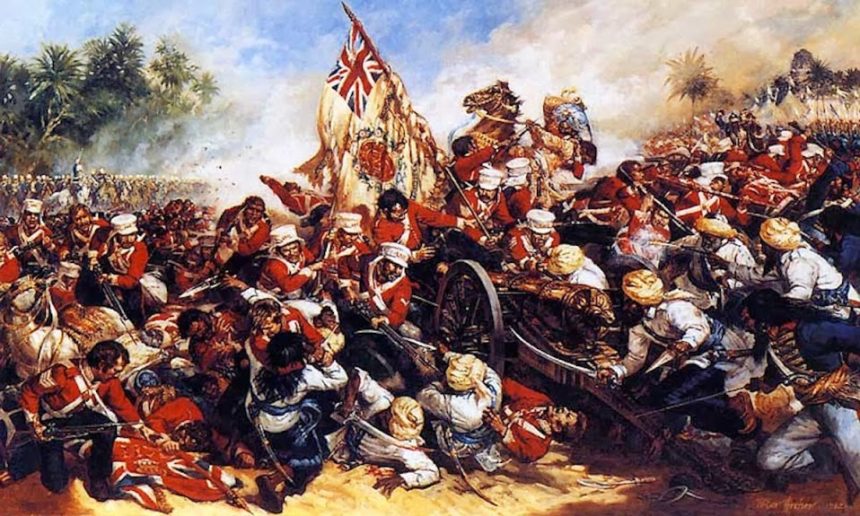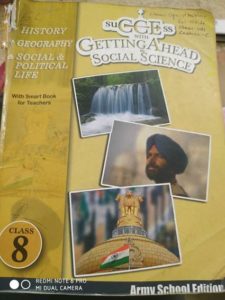The distortion of Hinduism at the altar of European historians for their own benefit has greatly dented the understanding of Indians themselves.
Glory and gluttony: Conscious Presentism

Presentism is the truth of history writing today. While the most subtle definition of Presentism is interpreting history and past events from a modern lens pertaining to which we tend to buy arguments offered by a Whig’s History (history used to glorify and validate past events, majorly undertaken by British Historians in 18th -19th century). This type of history is promoted by a school of historians who are simply apologists of inhumane history undertaken by their ancestors due to a false sense of legacy, validation, and a cronyistic sense of nationalism which effectively demolishes the nationalism carried out in the eastern cultures. We fail to appreciate the history and civilization that inspires a sense of nationalism in post-colonial countries of India, Sri Lanka, etc.
The mascot of this “school” was GWF Hegel (1770-1831) who extols the idea of History as a progression, as going forward, away from the past and thus was critical of History as a study of Origin of Humanity. His contemporary and opposition however were no good either, namely Johann Gottfried Herder (1774-1803) who romanticized Brahmins and at the behest of his internalized gluttony went on to demonize them, hence becoming the pioneer of establishing anti-science AIT (Aryan Invasion Theory) which was a myriad of conscious fabrication ranging from claiming ownership of Sanskrit and trace his native origins as Indo-European and pointing at Indian culture’s rather an existence as anachronistic vestiges of the superior European race. This went on to become the basis of Nazism, validation of Evangelical Genocides and justifying Colonialism which was also done by Novels like Treasure Island which aimed at indoctrinating teenagers with a mind that lionizes colonialists as ‘civilizers’ and sets up a toxic idea of machismo which suggested superiority complex, sexism, and pride on white heritage. This is Conscious Presentism which is a plank that rests on pillars of personal gain, gluttony, recognition, and glory. This neo-presentism as I call it is a way of presenting history with chosen bias and is done by an array of tactics of History Writing which are:
Firstly, Using suitable vocabulary (overly used adjectives, highly conclusive and judgmental than a factual form of writing).
Secondly, Avoiding Elaboration
Thirdly, Excerpts without Display of Context
Fourthly, Shaming Debates and Discrediting other Historians
This form of politics and ulterior motives drive Indology specifically into darkness and inaccessible to Indians by Institutional Bullying as faced by brilliant minds like Vishwa Adluri and Joy Bagchee or by dissolving the first rights of Indian Academia over Indian History by Academic demolition of Nationalism, Cartographic Identity, etc. or by promoting Subaltern Scholars who sign into their cabal for benefits aforementioned.
Many narratives that are formed by this faulty education are known as ‘Mughals made us rich’, ‘Tipu Sultan is a freedom fighter’, ‘Akbar was a secular king’ ‘British Colonisation brought us Modernization’, ‘Mahatma Gandhi is the Father of India’, ‘Modern Sciences has Western Roots’, etc.
I cannot cover them all here as they are not the main themes and topics of massive study themselves and the readership would be compelled to read an inconvenient length of these misconceptions which are neither brief nor verbose reports.
Albeit, I shall give the readers a couple of layman examples which are either primary school history lessons or lessons we learn as children by virtue of being Indians.
Excerpt from Ramayana:
| Conscious Presentism/ Neo-Presentism | David Hackett Fischer’s Nunc pro tunc History |
| Rama at return from his exile was praised by his subjects, however, a washerman blurted out a question over Sita’s integrity and piety which deeply hurt his masculinity and dented his vanity leading which he commanded Sita to perform a second ‘Agni Pariksha’. Sita refused to obey and was ousted from the palace and her status as queen was revoked after all she had rejected the proud and haughty king’s whim. Dejected the docile woman who sacrificed it all for the blind worship of her husband had nowhere to go and settled in the dense woods. | Rama’s return from exile was celebrated by his people lighting earthen lamps when suddenly a washerman blurted a question on Sita’s integrity and piety which made Rama believe it to be a uniform question in the kingdom. To quench this concern, Rama requested Sita for a second ‘Agni Pariksha’ which she refused and annoyed at this request returned to her home, her mother. Bhumija settled again in the forest. Rama sorrowful of misfortune continued to reign with a gold statue of Queen Sita. |
Firstly, the account on the left is not neo-presentist only because it diabolizes national icons like Rama and Sita but also misrepresents the occurrence with suitable vocabulary and bad adjectives making the account conclusive rather than a narration
Secondly, if truly Rama was a chauvinist, why would he have sent Hanumana to bring Sita back from Ravana’s Ashokavatika? He would have cared the least.
Thirdly, if truly was Rama vain and egotistical why would he accept Sita’s demand to bring her back with a battle and glory himself and not in deceit? Why would he travel 2599.6 km to rescue his beloved wife?
Fourthly, Sita is the epitome of independence, individuality and balance in a relationship. If truly she had been docile and timorous, why would she defy Rama’s order to rescue Sita by Hanumana? Why would she accompany Lord Rama to the forest against his will? Why would she cross the Lakshman Rekha if she obeyed all men in her life?
Fifthly, the individuality and antonymous relationship Sita and Rama share based on priorities in their lives and having a unique lens to judge situations and giving each other the autonomy to live with immiscible ideologies wouldn’t have been possible if neither sides were filled with love and respect for the other. This is Ramayana in essence. A saga of difference and not categorizing anyone or any circumstance as good or bad.
Sixthly, Sita was anything but docile or submissive, a kshatrani who lived life at her own terms at no one’s behest yet no one’s cost. Putting her principles static and candid on the table whether it resulted in leaving the joys and perks of a wife, queen or a mother. A story in Ramayana that shall prove the same and I borrow from Nityanand Misra Ji is:
“Once a sage crosses Sita in the forest during the exile. She tells Sita that she is utterly blessed as she has the three virtues one must comprise. Sita asks what are they? And the sage replies that you have a noble husband, a beautiful body and a sharp mind and you are an obedient wife. Sita politely thanked the Sage but corrects her by saying, “I do agree that I have a noble husband and a blessed physique and a sound mind but I am not sure if I am the obedient one in this relationship.”The story on the left suggests Rama to be a cruel and easily intimidated king and Sita as a woman who is docile. This is because this fits into the notion that all things old are sexist. Whereas the account on the right suggests Rama is in dilemma as a king and a husband.


Excerpt about Raja Ram Mohun Roy in class 8th success with getting ahead in social science by orient blackswan written by Vijaya Seshadri (ma history, ma English, med, MPhil in education)
I shall just write additional facts I believe should have been added to the excerpt originally to make it informative and not conclusive. Everybody knows about him. I would only disprove a few points and urge the reader to ask themselves:
- Has your opinion on R.R.M. Roy changed?
- Did you know these additional points?
- Do you think it was necessary to add these?
Let me know in the comments below.
| Original Excerpt Points | Additional Points |
| 1. Born in 1772 Orthodox family 2. Brahmo Samaj in 1830 3. Believed in monotheism and anti-idolatry important for the emancipation of women 4. Abolished Sati 5. Firm believer in Western Education 6. Father of Modern India 7. Established Presidency College |
1. He was a Mughal Embassador 2. Founded Brahmoism which is claimed to be a new form of Indic Religion that is progressive than Hinduism. 3. Never confronted the British on their sexist laws like property inheritance. 4. Went to Britain and emphasized on demolishing Oriental Education and omitting Sanskrit. 5. Coined the term ‘Hinduism’. Given the title of Father of Modern India by Gopal Krishna Gokhale. |
Firstly, RRM Roy was an Ambassador representing Akbar II and was given the title Raja by him.
Secondly, he has written Tufhat-ul-Muwahhidin in 1815 where he uses evangelical terms for Hindus like pagans and calls them ‘doll worshippers’.
Thirdly, was in collaboration with William Carey who was Hinduphobic and began the Serampore Seminary as RRM Roy later became a British Employee.
Fourthly, he supported Macaulayism. Macaulayism- education in English, of English by English till we leave behind a brigade of Indians that speak of British men and history with as much pride as a Brit himself and continue this form of Anglicist education.
Fifthly, this form of education continues in Civil Services, especially incorrect history from the 1976 NCERT book by Romila Thapar
Moreover, it promised Scientific Education which has not happened yet, we are still not as advanced as Europe whereas China, Japan and South Korea who refused to abandon their native language are technologically advanced, historically accurate and have based a market selling their own culture and traditions whereas India’s greatest market still is manufacturing Anglicised Indians.
Atheism, agnosticism and satanism
The trend of anglophilic Indian youth of the day is to mock the relevance of Indian practices like that of wearing toe-rings, wearing sindoor, yoga and smritis. These aforementioned anti-belief ‘cults’ (at best) are only due to the inadequacy of Abrahamic religions whereas superimposing contemporary ideas with ancient practices of India are still explained with scientific evidence and theoretical work known as Puranas.
Without any prevarication, these cabals of self-described pro-science groups are only relevant in a world of Abrahamic Religions as they are a cluster of non-scientific religions. In fact, the subscribers to alternate science like ‘flat-earthers’ believe in the NASA conspiracy because Bible says so in Isaiah:
“The earth takes shape like a clay under a seal; its features stand out like those of a garment”-JOB 38:14 (NIV) and
“ He (GOD) enthroned above the circle of the earth” – ISAIAH 40:20 (NIV).
Does the general perception then become that Religion cannot lead to scientific reasoning, but is Christianity the only religion? In Hinduism, the ‘varaah’ (Wild Boar) avatar of Vishnu has a round earth resting upon its tusks.
A born Hindu cannot deviate from these beliefs, at most can subscribe to only one dimension of Hinduism, not dismiss it in its entirety. Indian findings are the soul and essence of science known to all of humanity.
In a nutshell, Atheism etc. are Anglophilic, anti-Abrahamic beings who have accepted the fact that they have a moth-eaten conscience and wish to never use the evolved mind and justify all mishaps and immorality as HUMAN NATURE. Do not get too excited, the nut within is hollow, therefore these standpoints with reference to Hinduism begin and end at the very surface. Hence, the Hindu Vedic Society can be looked at from a presentist view but still emerges relevant, modern and foundation of holistic sustainability.
In conclusion, let there be none this time. Let there be facts at your disposal to ponder upon through the week.

Leave a Reply